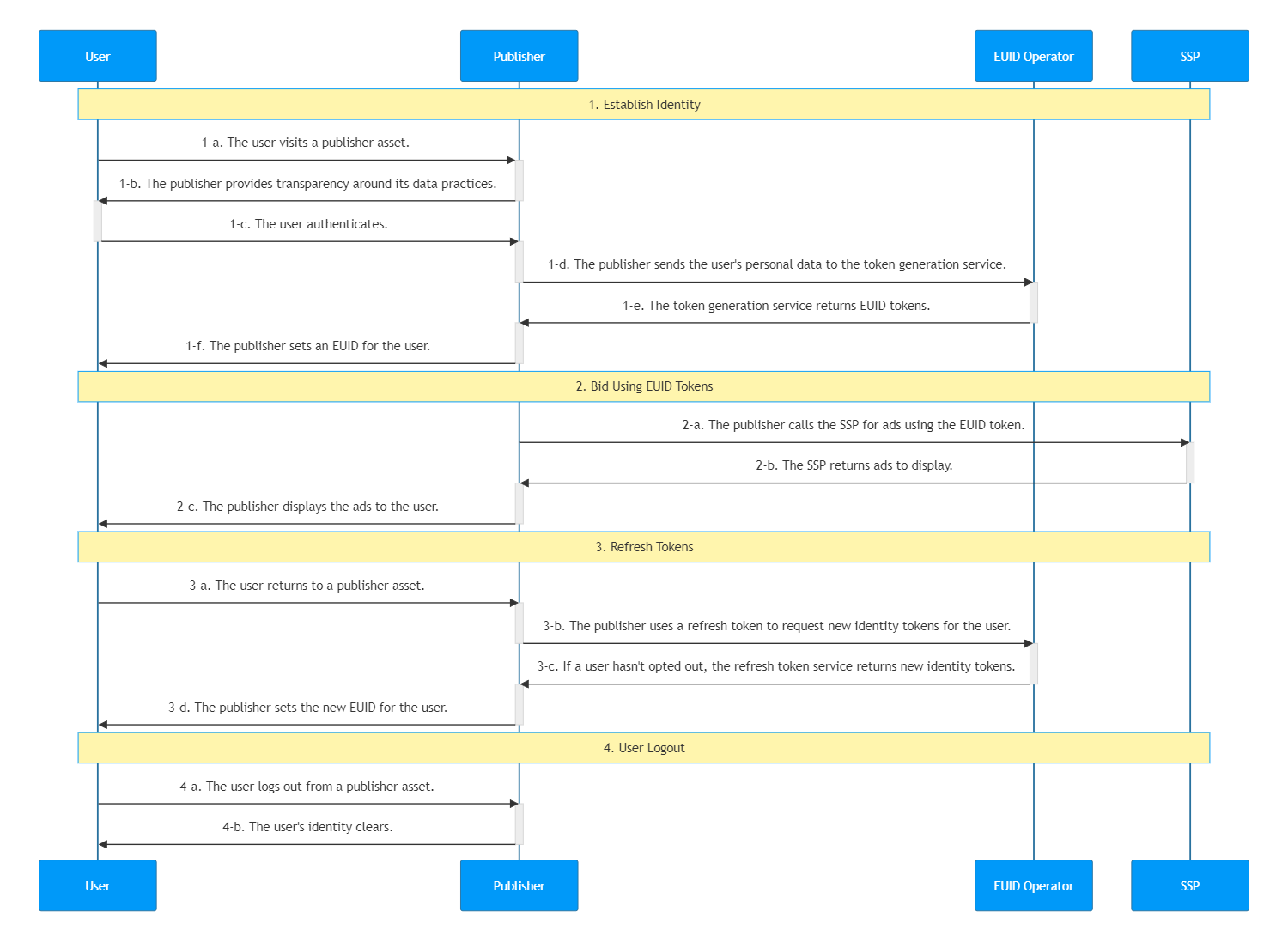Publisher Integration Guide, Server-Side
This guide is for publishers who want to integrate with EUID to generate EUID tokens (advertising tokens) for the RTB bidstream, with all integration activity on the server side.
The following options are available for publishers to integrate with EUID on the server side:
- SDK for Java (see Usage for Publishers section).
- SDK for Python (see Usage for Publishers section).
- Custom server code to generate and refresh the EUID token by calling the POST /token/generate and POST /token/refresh endpoints.
For a complete summary of publisher integration options, see Publisher Integrations.
To facilitate the process of establishing client identity using EUID and retrieving EUID tokens, consider using the SDK for JavaScript. For details, see Client-Server Integration Guide for JavaScript.
Introduction
The guide outlines the basic steps that you need to consider if you're building an integration without using a client-side or server-side SDK. For example, you need to decide how to do the following:
- Implement opportunities to capture email or phone number: for example, promotional exchanges, sign-ups and subscriptions, or marketing form fills.
- Manage EUID identity information and use it for targeted advertising
- Refresh EUID tokens
- Deal with missing identities
- Manage user opt-outs
See also FAQs.
Integrating with Single Sign-On (SSO)
If you integrate with one or more SSO providers to offer SSO login, you might be able to retrieve the logged-in user's email address from the SSO provider to generate EUID tokens.
For details, see Publisher Integration with SSO Providers.
Integration Steps
The following diagram outlines the steps required for a user to establish an EUID token with a publisher and how the EUID token integrates with the RTB bidstream.
If you're using a server-side SDK, the SDK takes care of all the steps that mention endpoints: for example, step 1-d, the publisher sends the user's personal data to the token generation service.

The following sections provide additional details for each step in the diagram:
- Establish identity: capture user data
- Bid using an EUID token
- Refresh an EUID token
- Clear Identity: user logout
Establish Identity: Capture User Data
After authentication in step 1-c, which allows the publisher to validate the user's email address or phone number, the publisher can send a request to generate an EUID token, on the server side. The following table details the token generation steps.
Rather than calling this endpoint directly, you could use one of the SDKs to manage it for you. For a summary of options, see SDKs: Summary.
| Step | Endpoint | Description |
|---|---|---|
| 1-d | POST /token/generate | Establish identity with EUID by using the POST /token/generate endpoint to generate an EUID token using the normalized email address or phone number of the user. |
| 1-e | POST /token/generate | Return an EUID token generated from the user's hashed or unhashed email address or phone number, plus associated values such as the refresh token. |
| 1-f | N/A | Place the returned advertising_token and refresh_token in a store tied to a user. You might consider client-side storage, such as a first-party cookie, or server-side storage. |
Bid Using an EUID Token
Consider how you want to manage EUID identity information and use it for targeted advertising; for example, to pass the returned EUID token to SSPs.
| Step | Endpoint | Description |
|---|---|---|
| 2-a | N/A | Send the advertising_token from step 1-e to the SSP for bidding. Send the value as is. |
For an example of what an EUID token might look like in the bidstream, when it's sent from an SSP to a DSP, see What does an EUID token look like in the bidstream?.
Refresh an EUID Token
Use the POST /token/refresh endpoint to make sure you always have a valid and up-to-date EUID token. The EUID token must be refreshed to sync with the EUID rotation. In addition, the token refresh process checks the user's opt-out status, and if the user has opted out, no new token is sent. This ends the token refresh chain, and you must not use that EUID token again.
For details about the EUID opt-out workflow and how users can opt out, see User Opt-Out.
| Step | Endpoint | Description |
|---|---|---|
| 3-a | N/A | When a user returns to an asset and becomes active again, refresh the EUID token before sending it to the SSP. |
| 3-b | POST /token/refresh | Send the refresh_token obtained in step 1-e as a query parameter. |
| 3-c | POST /token/refresh | The EUID service issues a new identity token for users that haven't opted out. |
| 3-d | N/A | Place the values returned by the POST /token/refresh endpoint, advertising_token and refresh_token, so that they are linked to the user. You might consider client-side storage, such as a first-party cookie, or server-side storage. |
Refresh tokens starting from the refresh_from timestamp, which is part of the identity returned by the POST /token/generate or POST /token/refresh endpoints.
Clear Identity: User Logout
If the user logs out, do not use the EUID token.
| Step | Endpoint | Description |
|---|---|---|
| 4-a | N/A | The user logs out from a publisher asset. |
| 4-b | N/A | Remove the EUID token you've stored for that user. No interaction with the EUID service is required. |
Sample Implementation
A sample implementation is available for server-side integration:
FAQs
For a list of frequently asked questions for the publisher audience, see FAQs for Publishers.